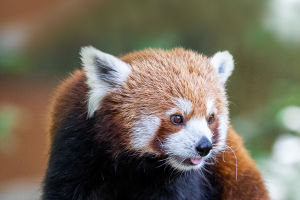Hares are an extremely fast-moving species that prefer cold weather and are often found in boreal forests and tundra.
Adult hares have darker fur, predominantly gray and blue-gray, interspersed with starbursts of yellow, and have a brownish-yellow dorsal body with irregular black spots on the dorsal spine.
The tailback hair color and body-back ventral hair are light earthy yellow, light brown, or white, while the rest is a different shade of brownish-brown. The hairs are long, fluffy, and soft in texture.
The hare has a small head and much smaller ears than the domestic rabbit. Compared to the cavity rabbit, the ears are slightly longer, and the tips are black.
The body size is much smaller than that of domestic rabbits, with a general body length of 35 to 43 cm and a tail length of 7 to 9 cm. An adult hare usually weighs around 2.5 to 3 kilograms.
The hare is very stealthy, and when it is not moving, its fur blends with the surrounding weeds, making it difficult to notice even if people approach within one meter.
Rabbits, whether wild or domestic, are usually not heard to bark, and it is commonly believed that rabbits do not bark. However, when frightened or captured, they will scream, especially when captured and make a sound similar to a baby's cry, which can be frightening to the timid.
Rabbits are generally solitary and do not have burrows in the ground. They rely on their speed to escape danger and can run up to 50 km/h.
Food
Rabbits feed on plants such as weeds and leaves and are fed a wide variety of forage, greens, and straw in captivity.
Differences between hares and rabbits
Hares live on the ground and need larger and longer ears to hear more subtle sounds and longer legs to escape. On the other hand, rabbits have burrows for cover, and their young cannot open their eyes when they are born.
The hare has two more chromosomes than the burrowing hare, a difference greater than that between a donkey and a horse. Therefore, hares and burrowing hares cannot interbreed and are two different animals.
Can rabbits in the wild be trapped?
First of all, it is important to distinguish whether the rabbit you see is a wild rabbit or a feral burrowing rabbit. All wild rabbits are on the red list and should be protected.
The burrowing rabbit, as you may know about Australia, is an extremely fertile animal that can easily flood the country, invading the resources of other animals and destroying pastures by digging massive holes.
Purebred hares are not easy to domesticate
It takes a long time to domesticate a purebred hare from the wild domestic, and we have not yet seen any reports of successful examples. The existing practice shows that it is not easy to domesticate a purebred hare, and it is difficult to raise it in captivity, much less to have a large-scale breeding population.
Rabbit farming is a regulated activity and requires approval from local wildlife management departments and a wildlife domestication breeding and processing business license.
Hares and rabbits are fascinating and beautiful animals that have unique features that allow them to survive in different environments. It is important to protect wild rabbits and be responsible when farming domestic rabbits to ensure their welfare and prevent harm to the environment.


